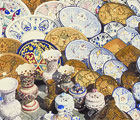 |
 |
 |
 |
 |
|
Modern Uses For Ceramics We commonly think of ceramics as art objects and decorations. But ceramics really are diverse pieces of multi-purpose material that are made from burning formed pieces of pottery. This shaped clay started out many years ago being hand-formed and was eventually made with a wheel to iron out any fingerprints or major imperfections.
POTTERY
|
|
Pottery Is The Eyes Of The Beholderby James MonahanIn the days of ancient Egypt, when the pharaohs rule the Nile and Osiris lorded over them, and before the age of the Maoist communism in China way back in the age of great dynasties and divided kingdoms there was one distinct craft that was considered the toast of kings and queens. In those times the streets are filled and lined up with all sorts of creations by different master that acclaim for themselves the right to be called "master potter." From days of long ago when the art of pottery was considered to be the greatest career anyone could ever venture and the pottery techniques are solely-owned by one family. Just like martial arts in some parts of the Asian region where they pass on to the next generation of the family lines the secret technique that can be found in their martial arts, potters have handed down from generation to generation the secret to what makes their pots stand out from the other. And from generation to generation the secret to pottery making has been a closely guarded knowledge up until the time when commercial pottery has taken over the good old hand made pots, vases, jars and other products of pottery. Today's way of life has taken off by leaps and bounds and the way we see pottery has greatly deteriorated from the time of the great kings. Potters nowadays rides a broomstick, waves his magic wand, has an owl for a pet and plays an out of this world game where you can literally die. The good years of the art of pottery has taken a back seat to a different kind of potter. Sad as it is children, even adults at this time never really recognize the historical and cultural impact of pottery in our society. Besides being one of the oldest means of livelihood in the post cavemen society, pottery speaks about the kind of life that an early civilization has. Pottery in ancient China was one of the major industries back then. Palaces were adorned with all shapes, sizes and kinds of pottery. Yet, unlike the crude concoction of mud and water baked until golden brown or dried under done for a day, the Chinese discovered the wonderful use of ceramic. Chinaware--which is what it's commonly called nowadays--is the pioneer product of the pottery world. Chinaware is intricately designed with scenery and calligraphy. Potteries during the age of the dynasties are abundant because of the diverse cultural influence of the Chinese. Unlike in the pottery in ancient Egypt, where everything was either made from red clay or dyed red and then painted on designs with the juice of berries and trees, Chinese pottery has reached a certain level of sophistication when it comes to production process. Pottery are not just crudely placed on a rotating wheel, shaped to a certain form, and afterwards baked in the sun. Pottery making in china offered not just a view at the kinds of industries they had but the kind of culture that they have developed. And way before the western colonizers ever set sail to the Newfoundland, the Asian and the African side of the world have set up a civilization based on camaraderie and progress. And thanks to the presence of ancient pottery, these truths are realized today to give us an idea what's it like to the pottery in the eye of the beholder. About the AuthorJames Monahan is the owner and Senior Editor of PotteryBase.com and writes expert articles about pottery.
|
|
�Copyright 2025 Tianxin-ceramic. All rights reserved.
Unauthorized duplication in part or whole strictly prohibited by international copyright law. |
